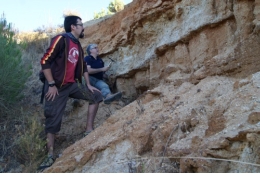‘Lepeichnus giberti’, a new trace fossil in the palaeontology world
Lepeichnus giberti is the name of the new trace fossil of the upper Miocene, very complex and exceptionally preserved, found in the town of Lepe (Huelva) and introduced in the magazine’s Palaeogeography, Palaeoclimatology, Palaeoecology article, signed by the experts Zain Belaústegui, Jordi Martinell and Rosa Domènech, members of the PaleoNeoMar group from the Department of Earth and Ocean’s Dynamics and the Institute for Research on Biodiversity of UB (IRBio); Fernando Muñiz (University of Huelva) and Maria Gabriela Mangano and Luis A. Buatois (University of Saskatchewan, Canada).
Belaústegui, Z.; Muñiz, F.; Mángano, M. G.; Buatois, L. A.; Domènech, R.; Martinell, J. «Lepeichnus giberti igen. nov. isp. nov. from the upper Miocene of Lepe (Huelva, SW Spain): Evidence for its origin and development with proposal of a new concept, ichnogeny», Palaeogeography, Palaeoclimatology, Palaeoecology, abril de 2016. Doi:10.1016/j.palaeo.2016.04.018
